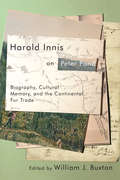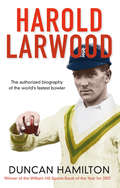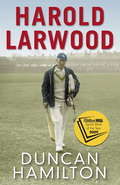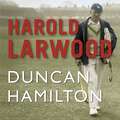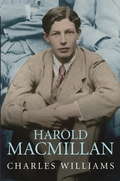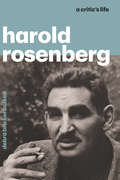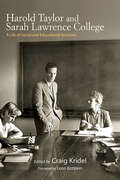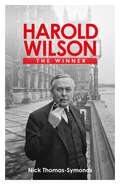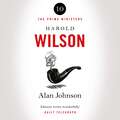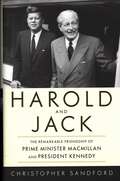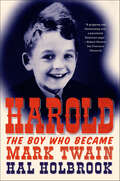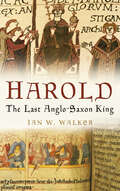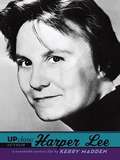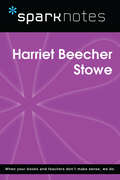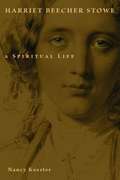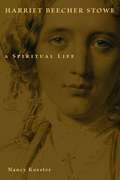- Table View
- List View
Harold Bell Wright: Storyteller to America (Great West and Indian Series, Vol #49)
by Lawrence V. Taggx
Harold Innis on Peter Pond: Biography, Cultural Memory, and the Continental Fur Trade
by William J. BuxtonBest known for his writings on economic history and communications, Harold Innis also produced a body of biographical work that paid particular attention to cultural memory and how it is enriched by the study of neglected historical figures. In this compelling volume, William Buxton addresses Innis's engagement with the legacy of the fur trader and adventurer Peter Pond. Harold Innis on Peter Pond comprises eight texts by Innis, including his 1930 biography of Pond as well as his writings on the explorer's myriad activities. The book also features a collection of eight letters exchanged between Innis and Florence Cannon, a descendent of Pond with a strong interest in her ancestor's life and times, and an unpublished 1932 article on Pond's 1773–75 activities as a fur trader on the upper Mississippi, written by Innis's former student R. Harvey Fleming. Situating Innis's writings on Pond in relation to his broader body of biographical work, Buxton interprets what these texts tell us about Innis's intellectual practice, historiography, and the writing of biography. The book explores how Innis's perspectives shifted with changing intellectual and political circumstances and shows that his advocacy of Pond as an unrecognized "father of confederation" challenged conventional views of Canadian nation-building. A critical edition of previously overlooked biographical texts, Harold Innis on Peter Pond traces what these writings disclose about the biographer's character and values even as they discuss their subject.
Harold Larwood
by Duncan HamiltonWinner of the William Hill Sports Book of the Year, this is the first ever biography of Harold Larwood. Larwood, one of the most talented, accurate and intimidating fast bowlers of all time is mainly remembered for his role in the infamous Bodyline series of 1932-3 which brought Anglo-Australian diplomatic relations to the brink of collapse.Larwood was made the scapegoat--and despite the fact he was simply following his captain's instructions, he never played cricket for England again. Devastated by this betrayal, he eventually immigrated to Australia, where he was accepted by the country that had once despised him.Acclaimed author Duncan Hamilton has gained unprecedented access to the late sportsman's family and archives to tell the story of a true working-class hero and cricketing legend.
Harold Larwood: the Ashes bowler who wiped out Australia
by Duncan HamiltonWinner of the William Hill Sports Book of the Year, this is the first ever biography of Harold Larwood. Larwood, one of the most talented, accurate and intimidating fast bowlers of all time is mainly remembered for his role in the infamous Bodyline series of 1932-3 which brought Anglo-Australian diplomatic relations to the brink of collapse. Larwood was made the scapegoat - and despite the fact he was simply following his captain's instructions, he never played cricket for England again. Devastated by this betrayal, he eventually emigrated to Australia, where he was accepted by the country that had once despised him. Acclaimed author Duncan Hamilton has gained unprecedented access to the late sportsman's family and archives to tell the story of a true working-class hero and cricketing legend.
Harold Larwood: the Ashes bowler who wiped out Australia
by Duncan HamiltonWinner of the William Hill Sports Book of the Year, this is the first ever biography of Harold Larwood. Larwood, one of the most talented, accurate and intimidating fast bowlers of all time is mainly remembered for his role in the infamous Bodyline series of 1932-3 which brought Anglo-Australian diplomatic relations to the brink of collapse.Larwood was made the scapegoat - and despite the fact he was simply following his captain's instructions, he never played cricket for England again. Devastated by this betrayal, he eventually emigrated to Australia, where he was accepted by the country that had once despised him.Acclaimed author Duncan Hamilton has gained unprecedented access to the late sportsman's family and archives to tell the story of a true working-class hero and cricketing legend.(P)2010 Quercus Editions Ltd
Harold Macmillan
by Charles WilliamsA masterly biography of a great Conservative Prime Minister (and publisher) - Harold Macmillan (1894-1986).Harold Macmillan was a figure of paradox. Outwardly, it was Edwardian elegance and civilised urbanity. Inwardly, it was emotional damage from his wife's open adultery and his progressive perplexity at the onward march of time.The First World War showed the courageous soldier. From then on, it was politics, rather than the family business of publishing, which was to be his future. Nevertheless, although he supported Churchill in the 1930s he was deemed boring - and certainly not ministerial material.All changed with the Second World War. Appointed Minister in Residence in North Africa, Macmillan's career flowered. After the War he became indispensable to Conservative Cabinets and as Churchill's Minister of Housing in the early 1950s he achieved the target, against all expectations, of 300,000 houses annually. Thereafter, he was Eden's Foreign Secretary and Chancellor but by then Macmillan had become openly ambitious. Over the Suez affair in 1956 he played a difficult - and somewhat devious - hand. Eden's resignation left him as the clear choice of his Cabinet colleagues to become Prime Minister.From 1957 to 1962, Macmillan was a good - some would say a great - Prime Minister. By 1962, however, his government was looking tired. The Profumo affair in 1963 was particularly damaging, and in the autumn of 1963 his health forced him to retire.
Harold Macmillan
by Lord Charles WilliamsA masterly biography of a great Conservative Prime Minister (and publisher) - Harold Macmillan (1894-1986).Harold Macmillan was a figure of paradox. Outwardly, it was Edwardian elegance and civilised urbanity. Inwardly, it was emotional damage from his wife's open adultery and his progressive perplexity at the onward march of time.The First World War showed the courageous soldier. From then on, it was politics, rather than the family business of publishing, which was to be his future. Nevertheless, although he supported Churchill in the 1930s he was deemed boring - and certainly not ministerial material.All changed with the Second World War. Appointed Minister in Residence in North Africa, Macmillan's career flowered. After the War he became indispensable to Conservative Cabinets and as Churchill's Minister of Housing in the early 1950s he achieved the target, against all expectations, of 300,000 houses annually. Thereafter, he was Eden's Foreign Secretary and Chancellor but by then Macmillan had become openly ambitious. Over the Suez affair in 1956 he played a difficult - and somewhat devious - hand. Eden's resignation left him as the clear choice of his Cabinet colleagues to become Prime Minister.From 1957 to 1962, Macmillan was a good - some would say a great - Prime Minister. By 1962, however, his government was looking tired. The Profumo affair in 1963 was particularly damaging, and in the autumn of 1963 his health forced him to retire.
Harold Nicolson
by Norman RoseHarold Nicolson was a man of extraordinary gifts. A renowned politician, historian, biographer, diarist, novelist, lecturer, journalist, broadcaster and gardener, his position in society and politics allowed him an insight into the most dramatic events of British, indeed world, history.Nicolson's personal life was no less dramatic. Married to Vita Sackville-West, one of the most famous writers of her day, their marriage survived, even prospered, despite their both being practising homosexuals. Unashamedly elitist, bound together by their literary, social, and intellectual pursuits, moving in the refined circles of the Bloomsbury group they viewed life from the rarified peaks of aristocratic haughtiness. Few men could boast such gifts as Nicolson possessed, yet he ended his life plagued by self-doubt. 'I am attempting nothing; therefore I cannot fail,' he once acknowledged. What went wrong? It was a question that haunted Nicolson throughout his adult life. Relying on a wealth of archival material, Norman Rose brilliantly disentangles fact from fiction, setting Nicolson's story of perceived failure against the wider perspective of his times.
Harold Rosenberg: A Critic‘s Life
by Debra Bricker BalkenDespite being one of the foremost American intellectuals of the mid-twentieth century, Harold Rosenberg (1906–1978) was utterly incapable of fitting in—and he liked it that way. Signature cane in one hand and a cigarette in the other, he cut a distinctive figure on the New York City culture scene, with his radiant dark eyes and black bushy brows. A gangly giant at six foot four, he would tower over others as he forcefully expounded on his latest obsession in an oddly high-pitched, nasal voice. And people would listen, captivated by his ideas. With Harold Rosenberg: A Critic’s Life, Debra Bricker Balken offers the first-ever complete biography of this great and eccentric man. Although he is now known mainly for his role as an art critic at the New Yorker from 1962 to 1978, Balken weaves together a complete tapestry of Rosenberg’s life and literary production, cast against the dynamic intellectual and social ferment of his time. She explores his role in some of the most contentious cultural debates of the Cold War period, including those over the commodification of art and the erosion of individuality in favor of celebrity, demonstrated in his famous essay “The Herd of Independent Minds.” An outspoken socialist and advocate for the political agency of art, he formed deep alliances with figures such as Hannah Arendt, Saul Bellow, Paul Goodman, Mary McCarthy, Jean-Paul Sartre, Willem de Kooning, and Jackson Pollock, all of whom Balken portrays with vivid accounts from Rosenberg’s life. Thoroughly researched and captivatingly written, this book tells in full Rosenberg’s brilliant, fiercely independent life and the five decades in which he played a leading role in US cultural, intellectual, and political history.
Harold Rosenberg: A Critic‘s Life
by Debra Bricker BalkenDespite being one of the foremost American intellectuals of the mid-twentieth century, Harold Rosenberg (1906–1978) was utterly incapable of fitting in—and he liked it that way. Signature cane in one hand and a cigarette in the other, he cut a distinctive figure on the New York City culture scene, with his radiant dark eyes and black bushy brows. A gangly giant at six foot four, he would tower over others as he forcefully expounded on his latest obsession in an oddly high-pitched, nasal voice. And people would listen, captivated by his ideas. With Harold Rosenberg: A Critic’s Life, Debra Bricker Balken offers the first-ever complete biography of this great and eccentric man. Although he is now known mainly for his role as an art critic at the New Yorker from 1962 to 1978, Balken weaves together a complete tapestry of Rosenberg’s life and literary production, cast against the dynamic intellectual and social ferment of his time. She explores his role in some of the most contentious cultural debates of the Cold War period, including those over the commodification of art and the erosion of individuality in favor of celebrity, demonstrated in his famous essay “The Herd of Independent Minds.” An outspoken socialist and advocate for the political agency of art, he formed deep alliances with figures such as Hannah Arendt, Saul Bellow, Paul Goodman, Mary McCarthy, Jean-Paul Sartre, Willem de Kooning, and Jackson Pollock, all of whom Balken portrays with vivid accounts from Rosenberg’s life. Thoroughly researched and captivatingly written, this book tells in full Rosenberg’s brilliant, fiercely independent life and the five decades in which he played a leading role in US cultural, intellectual, and political history.
Harold Taylor and Sarah Lawrence College: A Life of Social and Educational Activism (Excelsior Editions)
by Craig Kridel; Leon BotsteinWinner of the 2023 Outstanding Book Award presented by the Society of Professors of Education Harold Taylor and Sarah Lawrence College is the posthumous memoir of Harold Taylor (1914–1993) told through thoughtful and entertaining accounts of his many interactions with leading cultural and political figures of his time. Taylor distinguished himself as a spokesperson for progressive education and educational experimentation during the 1950s and would emerge in the 1960s as one of the country's leading public intellectuals and campus speakers, addressing issues related to student activism, peace education, and international studies. Written with insight and wit and carefully edited and reconstructed, Harold Taylor and Sarah Lawrence College will inspire college students, professors, and administrators to reconsider the most fundamental purposes of higher education and social and educational change.
Harold Wilson: The Winner
by Nick Thomas-SymondsHarold Wilson is the only post-war leader of any party to serve as Britain's Prime Minister on two separate occasions. In total he won four General Elections, spending nearly eight years in Downing Street. Half a century later, he is still unbeaten, Labour's greatest ever election winner. How did he do it - and at what cost?Critics then and now have painted him as an opportunistic political calculator, even as a Soviet secret agent. In this powerful new portrait, drawing on previously unavailable sources and first-hand parliamentary insight, acclaimed biographer Nick Thomas-Symonds reveals a more complex figure. Wilson was a new kind of politician but, in his own way, this media-savvy harbinger of modernity was also a deeply traditional man, whose actions often suggest nothing less than a spiritual mission.In an intriguing paradox, Wilson, influenced by the distinctively democratic faith of his Yorkshire boyhood, united a fractured Labour Party, ushering in the cultural and social changes of the 'swinging sixties'. His was the government to decriminalise homosexuality, legalise abortion and abolish capital punishment. With a brilliant mind, sure-footed political moves and a feel for public opinion, he was a survivor who over and over again emerged from desperate crises - even, perhaps, conspiracies - to lead his party to victory. It is time at last to learn his secrets.
Harold Wilson: Twentieth Century Man (The Prime Ministers)
by Alan JohnsonThe ex-politician and bestselling author Alan Johnson, who was a Labour cabinet minister under Tony Blair and Gordon Brown, takes on the life and premierships of Harold Wilson.
Harold and Jack: The Remarkable Friendship of Prime Minister Macmillan and President Kennedy
by Christopher SandfordAcclaimed biographer Christopher Sandford tells the engrossing story of the unlikely friendship between British Prime Minister Harold Macmillan and President John F. Kennedy, a crucial political and personal relationship during the most dangerous days of the Cold War. This is the story of the many-layered relationship between two iconic leaders of the mid-twentieth century—British Prime Minister Harold Macmillan and American President John F. Kennedy. Based on previously unquoted papers and private letters between both the leaders themselves and their families, more than half of which are available for the first time, critically acclaimed biographer Christopher Sandford reveals a host of new insights into the ways these two very different men managed to bring order out of chaos in an age of precarious nuclear balance. Sandford traces the emotional undercurrents that linked Macmillan and JFK—and sometimes estranged them. The author's personalized narrative delves into the maneuverings behind the scenes of major political events: dealing with the disastrous Bay of Pigs episode in Cuba, responding to the provocative Soviet act of building the Berlin Wall, the tense back-and-forth consultations during the Cuban missile crisis, and the serious disagreement between the two allies over the Skybolt nuclear deterrent, which almost caused a major rift in US-British relations. Also presented are vivid portraits of the two first ladies and many extracts from personal papers that reveal the human factor rarely glimpsed by the public. With a wealth of new information in an engaging narrative, this book offers a vividly told historical account of two key figures of twentieth-century history, whose legacy helped shape our world today.
Harold: The Boy Who Became Mark Twain
by Hal HolbrookIn Harold: The Boy Who Became Mark Twain, the beloved stage, film, and television actor Hal Holbrook presents an affecting memoir about his struggle to discover his true self, even as he learned to transform himself onstage.Abandoned by his mother and father when he was two, Holbrook and his two sisters commenced separate journeys of survival. Raised by his powerful grandfather, who died when Holbrook was twelve, he spent his childhood at boarding schools, visiting his father in an insane asylum and hoping his mother would suddenly surface in Hollywood.As World War II engulfed Europe, Holbrook began acting almost by accident. Through war, marriage, and the work of honing his craft, his fear of insanity and his fearlessness in the face of risk were channeled into discovering that the riskiest path of all—success as an actor—would be his birthright. The climb up that forbidding mountain was a lonely one. And how he achieved it—the cost to his wife and children and to his own conscience—is the dark side of the fame he would eventually earn by portraying the man his career would forever be most closely associated with: Mark Twain.“If I were to conjure an image of an individual who best fits the phrase ‘a real American,’ it would be Hal Holbrook. This book shows him as a complete person. You will be compelled by the wit and wisdom of this beautifully composed story of self-determination and survival.”—Robert Redford
Harold: The Last Anglo-Saxon King
by Ian W. WalkerKing Harold Godwineson (c.1022-66) is one of history's shadowy figures, known mainly for his defeat and death at the Battle of Hastings. His true status and achievements have been overshadowed by the events of October 1066 and by the bias imposed by the Norman victory. In truth, he deserves to be recalled as one of England's greatest rulers. Harold: The Last Anglo-Saxon King sets out to correct this distorted image by presenting Harold's life in its proper context, offering the first full-length critical study of his career in the years leading up to 1066. Ian Walker's carefully researched critique allows the reader to realistically assess the lives of both Harold and his rival William, significantly enhancing our knowledge of both.
Harper Lee
by Kerry MaddenRead Kerry Madden's posts on the Penguin Blog. Nelle Harper Lee's To Kill a Mockingbird was published in 1960 and became an instant bestseller. Two years later it was an Academy Award- winning film. Today, it remains standard--and beloved--reading in English classes. But Lee never wanted "the book" to define who she was, which explains her aversion to any kind of publicity. Kerry Madden conducted extensive research for this Up Close biography, which reveals Lee to be a down-to-earth Southern woman who enjoys baseball games and playing golf--and whose one and only published book happened to win the Pulitzer Prize.
Harpoon at a Venture
by Gavin MaxwellIn this memoir, the Scottish naturalist and author of Ring of Bright Water recounts his post-World War II life as a shark fisherman in the Hebrides. A shark fishery based on the tiny Hebridean island of Soay was the beginning of Gavin Maxwell&’s enduring love affair with the west coast of Scotland. This, his first book, tells the whole story—the challenge and drama of the shark hunt, the development of catching techniques and equipment, the men who worked with him, and some of the frustrations of starting a new enterprise in post-war Scotland. Every chapter is packed with action and anecdote. In each there are also beautifully observed descriptions of sky, sea and the individual islands of the Hebrides as well as their wildlife—from gannets, puffins, Manx shearwaters, and fulmars to seals, dolphins, and whales.
Harrier: How To Be a Fighter Pilot
by Paul TremellingDiscover the exhilarating first-hand account of one man's white-knuckle life as a fighter pilot with the Royal Navy Sea Harriers'Searingly honest, keenly observed, well written and extremely funny' RAF NEWS'Puts you in the cockpit for carrier landings, missile firings and some of the most intense close air support stories imaginable' MIKE SUTTON____________Few have what it takes to be a fighter pilot. From the cockpit to the crew room, the pressure is relentless. One mistake is the difference between life and death. But in the air, you'll never feel more alive . . .Paul Tremelling knows this better than anyone. With nearly 20 years of experience, he puts you in the pilot's seat in this thrilling first-hand account of a life in combat.From saving the lives of heroes under fire in Afghanistan, to performing a night trap on a pitching aircraft carrier deck, this is life as you've never experienced it before.Strap in, it's time for take-off . . .____________'An outstanding first-hand account from inside the cockpit, told with flair and humour' JOHNNY MERCER MP, author of We Were Warriors'The storytelling wouldn't be out of place in a thriller. If you are going to take one book on holiday it has to be Harrier . . . it's a superb read. You won't be able to put it down' Aerospace'Mad, bad and dangerous to know . . . Tremelling lights the burners in an extraordinary memoir that leaves most military memoirs sitting behind in the hangar' JAMES BRABAZON, author of My Friend the Mercenary'This isn't a book for the faint-hearted. It is a book for anyone who appreciates insight into how a fighter pilot trains, trains more, thinks (fast), handles the aircraft and onboard tech . . . then fights' FLYER'Tremmers puts you in the cockpit for carrier landings, missile firings and some of the most intense close air support sorties imaginable. Insightful, laced with humour, and highly recommended' MIKE SUTTON, author of Typhoon'An inspiring, enlightening and thrilling insight into how modern aviators earn their pay. The stories from Afghanistan alone are justification enough to read this brilliant book. A masterpiece' PAUL BEAVER, author of Spitfire People 'A memoir that reads like a fast-paced thriller. Harrier launches straight onto the classics shelf of aviation literature' JOHN TEMPLETON SMITH, author of White Lie
Harriet Beecher Stowe (SparkNotes Biography Guide)
by SparkNotesHarriet Beecher Stowe (SparkNotes Biography Guide) Making the reading experience fun! SparkNotes Biography Guides examine the lives of historical luminaries, from Alexander the Great to Virginia Woolf. Each biography guide includes:An examination of the historical context in which the person lived A summary of the person&’s life and achievements A glossary of important terms, people, and events An in-depth look at the key epochs in the person&’s career Study questions and essay topics A review test Suggestions for further reading Whether you&’re a student of history or just a student cramming for a history exam, SparkNotes Biography guides are a reliable, thorough, and readable resource.
Harriet Beecher Stowe and the Beecher Preachers
by Jean FritzHarriet Beecher Stowe, a housewife with six children, opposed slavery with a passion. In 1852 her novel, Uncle Tom's Cabin, was published and Harriet became an instant celebrity.
Harriet Beecher Stowe: A Spiritual Life (Library Of Religious Biography)
by Nancy Koester"So you're the little woman who started this big war," Abraham Lincoln is said to have quipped when he met Harriet Beecher Stowe. Her 1852 novel Uncle Tom's Cabin converted readers by the thousands to the anti-slavery movement and served notice that the days of slavery were numbered. Overnight Stowe became a celebrity, but to defenders of slavery she was the devil in petticoats. <P><P> Most writing about Stowe treats her as a literary figure and social reformer while downplaying her Christian faith. But Nancy Koester's biography highlights Stowe's faith as central to her life -- both her public fight against slavery and her own personal struggle through deep grief to find a gracious God. Having meticulously researched Stowe's own writings, both published and un-published, Koester traces Stowe's faith pilgrimage from evangelical Calvinism through spiritualism to Anglican spirituality in a flowing, compelling narrative.
Harriet Beecher Stowe: A Spiritual Life (Library of Religious Biography (LRB))
by Nancy Koester"So you're the little woman who started this big war," Abraham Lincoln is said to have quipped when he met Harriet Beecher Stowe. Her 1852 novel Uncle Tom’s Cabin converted readers by the thousands to the anti-slavery movement and served notice that the days of slavery were numbered. Overnight Stowe became a celebrity, but to defenders of slavery she was the devil in petticoats.Most writing about Stowe treats her as a literary figure and social reformer while downplaying her Christian faith. But Nancy Koester's biography highlights Stowe’s faith as central to her life -- both her public fight against slavery and her own personal struggle through deep grief to find a gracious God. Having meticulously researched Stowe’s own writings, both published and un-published, Koester traces Stowe's faith pilgrimage from evangelical Calvinism through spiritualism to Anglican spirituality in a flowing, compelling narrative.Watch a 2014 interview with the author of this book here:
Harriet Beecher Stowe: The Inspiring Life Story of the Abolition Advocate (Inspiring Stories)
by Brenda HaugenIn the years leading up to the bloody Civil War, the issue of slavery divided the United States. Harriet Beecher Stowe hated slavery and used her gift of writing to fight its injustice. Her novel, Uncle Tom's Cabin, revealed the cruelties of slavery and further split an already divided country.
Harriet Jacobs
by Jean Fagan YellinHarriet Jacobs's Incidents in the Life of a Slave Girl remains the most-read woman's slave narrative of all time. Jean Fagan Yellin recounts the experiences that shaped Incidents-the years Jacobs spent hiding in her grandmother's attic from her sexually abusive master-as well as illuminating the wider world into which Jacobs escaped. Yellin's groundbreaking scholarship restores a life whose sorrows and triumphs reflect the history of the nineteenth century, from slavery to the Civil War, to Reconstruction and beyond.

